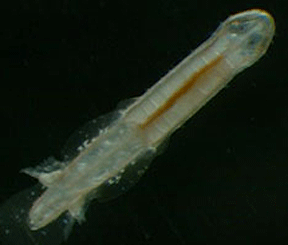
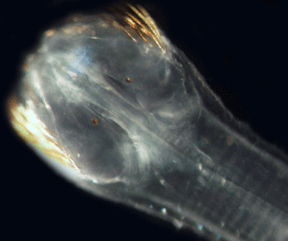
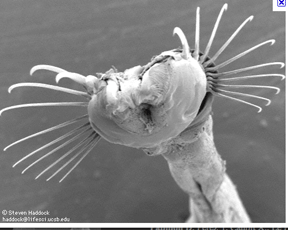
Chaetognatha
Chaetognaths are a very homogenous group in terms of bauplan, all are small, long, thin and possess side fins and and tail fins. They swim by means of their tail fins, the side fins being used only for stabilization. They may in fact be the primary predator in many planktonic environments. Larger species may reach 10cm (4 inches)or more in length and are known to attack small fish. Some have a neurotoxic venom. They have a series of movable spines on their head which they use to grasp and hold their prey while it is eaten. They have a strange hood, part of their body wall, which they can drag over the the spines and the rest of their head, when they are not eating. Some texts maintain that they only have longitudinal muscles.



Their development is direct as it is in deuterostomes, but they share other characteristics with other groups. They have a chitinous cuticle and a ventral nervous system that somewhat resembles that found in Kinorhyncha and Priapulida. If you construct a tree without Priapulid, they map close to Mollusks and Annelids, if you include Priapulids they map closer to this group. They, however, do not molt.
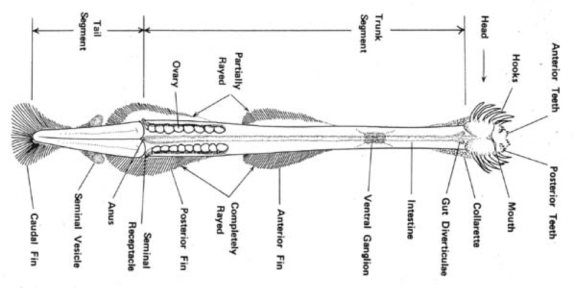
They are hermaphrodites.
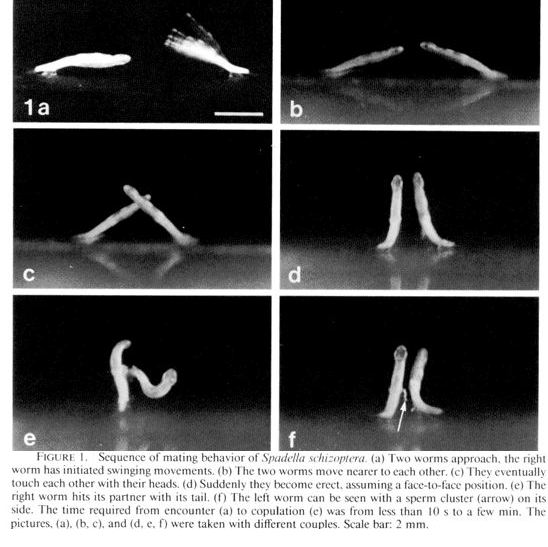
The fertilization biology of chaetognaths is also very interesting. The sperm has to pass through a so called accessory fertilization cell in order to enter the egg. This probably allows the female function a lot of control over which sperm gets access to the eggs.
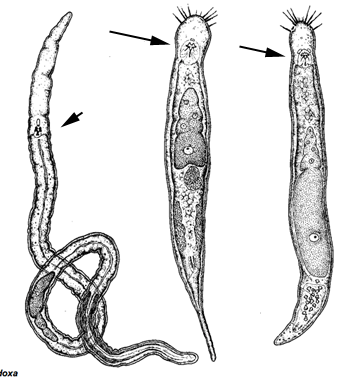
Gnathostomulids are microscopic acoelomate marine worms that have a characteristic feeding apparatus made of a hard noncellular material.
Gnathostomulids are found mainly in shallow salty waters down to a depth of several hundred meters and in the spaces between sand grains. Gathostomulids have transparent bodies 0.3 to 1.0 mm long; a slight constriction separates the head from the trunk, and there is no external cuticle. They have no circulatory or respiratory organs and no skeleton. There is a modest nervous system in the outer epithelial layer. In some species, the head bears well-developed sense organs. stiff bundles of cilia and pits lined with cilia, collectively called the sensorium.
On the belly side of the head are the feeding structures: a hard comblike basal plate (used for grazing on films of bacteria, protists, and fungi), two lips, a mouth, and a pair of toothed lateral jaws within a muscular pharynx. The jaws work rapidly, snapping open and closed in about a quarter of a second. Particles of food are passed into the gut, a tubular sac having no anus and undigested food leaves by the mouth. There doesn't appear to be an anus. A pair of excretory organs, each made of two or three modified protonephridia(curved cells), is located on the sides of the bursa.
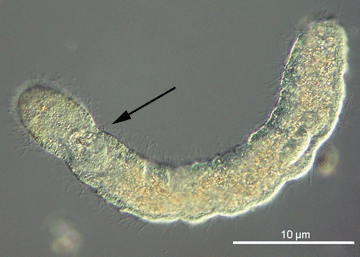
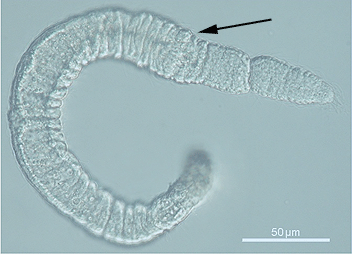
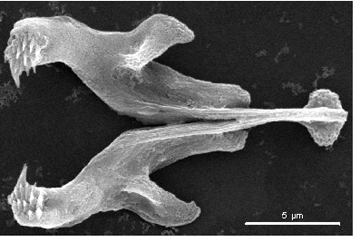
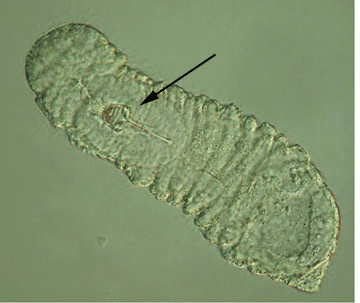
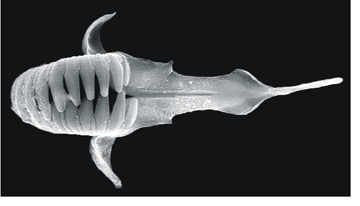
They move using a combination of muscles and cilia. There is usually one one cilia per cell in the epithelium.
Their jaw structure may relate gnathostomulids to rotifers; on the other hand, monociliated epithelium has been found only in gastrotrichs and gnathostomulids.
They are hermaphroditic. In some species at least sperm are injected straight through the body wall, though others have a vagina. the large eggs develop one at a time, fertilization is internal, sperm being stored in special sac called a 'bursa' until needed. The eggs leave the body by bursting out through the adults body wall, healing of the adult is quick and there is no larval stage, the egg hatching directly into a small but adult gnathostomulid.
Only one species, Limnognathia maerski, has been described.
With sizes averaging one-tenth of a millimeter, these are some of the smallest animals known.
Micrognathozoa have very complicated jaws, with fifteen separate elements. The parts of the jaw structure are connected by ligaments and muscles. The jaw parts are very small, ranging from 4 to 14 μm. The animal can extend part of its jaw structure outside of its mouth while eating. It also extends much of its jaw structure outside of its mouth when it is regurgitating items that are indigestible. Cilia on the forehead create a current that moves food particles towards the mouth. The other cilia move the animal. Protonephridia present
http://www.zmuc.dk/inverweb/dyr/limnognathia/jaws/3_D/jaws_3D_uk.htm
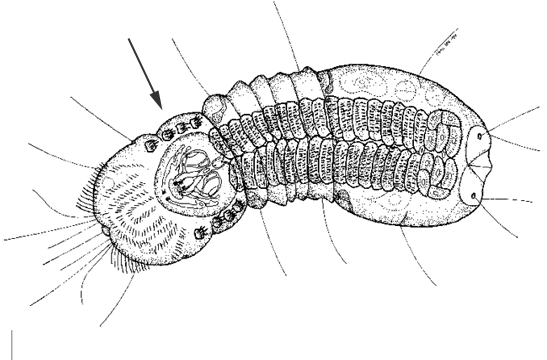
They lay two kinds of eggs: thin-walled eggs that hatch quickly, and thick-walled eggs that are believed to be resistant to freezing, and thus capable of over-wintering and hatching in the spring. The youngest L. maerski specimens collected may also have male organs, and it is now theorized that the animals hatch as males and then become females
In 1995 scientists discovered tiny, worm-like creatures living on the mouthparts of the Norway lobster. Now considered a new clade, Cycliophora.
They have a circular mouth lined with cilia that is used for feeding or moving pieces of food produced by the lobster feeding into this commensal's mouth. Beneath the mouth is a body housing a U shaped gut , which ends in an adhesive disc that sticks onto tiny hairs and bristles of the lobster. The whole animal is only about 0.35 millimeters long, small enough that there can be hundreds on each lobster!
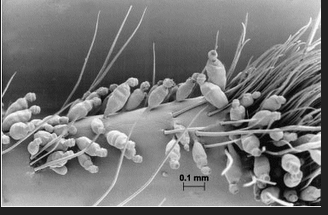
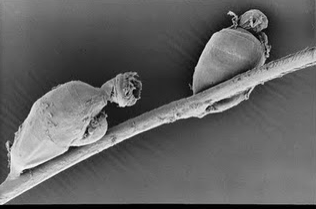
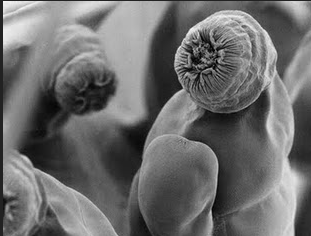
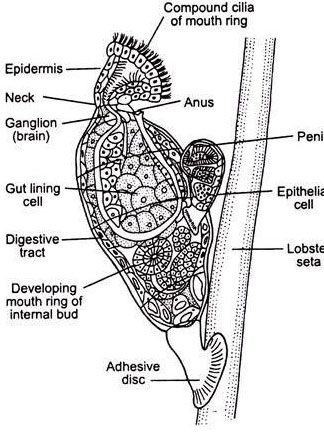
They can create a Pandora larva that will grow into another feeding adult. A feeding adult can also produces a female larvae that will stay inside the feeding adult until male larvae are present. Finally . Adults can also produce a male larva, who will swim along and attach itself to another feeding adult. This will later produce not one but 2 or 3 males, each with a nervous system, brain, muscles and cilia. Male larvae are only about 0.08 mm long and have no gut. Female larvae also do not feed and when she is released from her mother is fertilized by a male. She soon encyst allowing the egg she carries to develop. In time, yet another larva hatches from the egg and emerges from the cyst. This is the chordoid larva, which will swim off to discover a whole new lobster and hopefully establish a new colony.
http://www.eartharchives.org/articles/the-hitchhiker-s-guide-to-the-lobster-s-face/
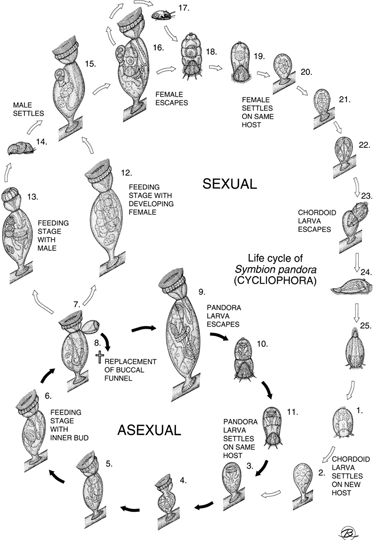
The molecular data (study of 18S rRNA/DNA sequences) indicate that cycliophorans are a sister-group to the Syndermata which includes Rotifera and Acanthocepha.